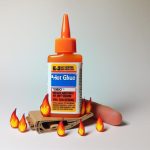Are you tired of constantly tightening loose metal fixtures on your concrete surfaces? From railings to mailboxes, attaching metal to concrete can be a tricky task. But don’t fret, fellow DIYers.
With the right techniques and products, you can create a strong and long-lasting bond between metal and concrete.
Here are some key tips to remember when gluing metal to concrete:
- The first step is crucial – make sure both surfaces are clean and free of any debris. This will ensure better adhesion and a stronger bond.
- Use a high-quality adhesive specifically designed for bonding metal to concrete. Epoxy or polyurethane-based adhesives work best for this purpose.
- Apply the adhesive evenly on both surfaces using a putty knife or trowel.
- For added strength, consider using mechanical fasteners like screws or anchors in addition to the adhesive.
- Allow enough curing time before putting weight or stress on the bond. This can vary from 24 hours to several days depending on the chosen product.
Now that you have the basics down, go forth with confidence and securely attach your metal fixtures onto concrete surfaces.
Table of Contents
- 1 Choosing the Right Adhesive
- 2 Surface Preparation
- 2.1 Step 1: Gather necessary safety equipment
- 2.2 Step 2: Clean the surfaces
- 2.3 Step 3: Be aware of potential hazards
- 2.4 Step 4: Use an electric trowel
- 2.5 Step 5: Drill holes in the concrete
- 2.6 Step 6: Apply adhesive
- 2.7 Step 7: Allow for proper curing time
- 2.8 Step 8: Consider using a heat gun
- 2.9 Step 9: Recommended adhesives
- 3 Application Techniques
- 4 Curing and Finishing
- 5 Conclusion
Choosing the Right Adhesive
Choosing the right adhesive is crucial for creating a strong and durable bond when gluing metal to concrete.
It requires careful consideration of various factors, including the type of metal, intended use, thermal and mechanical loads, surface preparation, safety precautions, other bonding options, cure time and strength, surface orientation, application method, and finishing techniques.
These elements must be taken into account to ensure a successful bond between metal and concrete.
One key factor to consider is the type of metal being bonded. Different metals have unique properties that may require a specific type of adhesive. For example, epoxy resin adhesives are suitable for bonding non-ferrous metals, while liquid metal adhesives are best for high-stress repairs on materials like stainless steel.
It’s also essential to think about the purpose of the bond and the environmental conditions it will be exposed to. For outdoor use, a waterproof adhesive like polyurethane may be the best choice. Additionally, if the bond will experience high temperatures or heavy loads, it’s crucial to choose an adhesive that can withstand these conditions.
Proper surface preparation is vital to ensure a successful bond. This includes cleaning and roughening both the metal and concrete surfaces before applying the adhesive. It’s also essential to take necessary safety precautions while working with metal adhesives as they may contain harmful chemicals. Wearing gloves and working in a well-ventilated area is recommended.
In some cases, mechanical fasteners such as bolts and screws may provide a stronger bond than adhesive alone. It’s essential to consider using these options for heavy loads or high-stress applications.
The cure time and strength of an adhesive are also critical factors to consider. Adhesives vary in their cure time and bond strength, so it’s crucial to follow instructions carefully and allow enough time for the adhesive to cure before applying any pressure or load.
The orientation of the metal and concrete surfaces can also affect the choice of adhesive. For vertical surfaces, a notched trowel or brush may be necessary to evenly distribute the adhesive. Additionally, depending on the type of adhesive, different application methods may be required for optimal results. For example, using a cartridge gun can help control the flow of adhesive for overhead applications.
After the adhesive has cured, finishing techniques such as sanding or painting can be used to give a polished look. However, rushing the curing process or not following instructions may result in a weak bond that may require reapplication or a different adhesive.
Surface Preparation
Achieving a strong and long-lasting bond between metal and concrete requires proper surface preparation. Here are the essential steps for preparing the surface before gluing metal to concrete:
Step 1: Gather necessary safety equipment
Before starting any project, it’s important to have the proper safety equipment on hand.
This includes gloves, a respirator, and eyewear to protect against potential hazards associated with adhesives.
Step 2: Clean the surfaces
Using a cloth or brush, thoroughly clean both the metal and concrete surfaces to remove any dirt, dust, or debris.
This will create a smooth and clean surface for the adhesive to bond to.
Step 3: Be aware of potential hazards
Different adhesives have varying properties and may react differently when used on certain materials.
It’s crucial to be aware of potential hazards such as chemical reactions, fire risks, or heat shrinkage when selecting an adhesive for your project.
Step 4: Use an electric trowel
For a stronger attachment between metal and concrete, use an electric trowel to create a rough surface on the concrete.
This will aid in better bonding with the adhesive.
Step 5: Drill holes in the concrete
Drilling holes in the concrete can also help create a more robust bond between the two materials.
After drilling, spray water into the holes to remove any dust or debris.
Step 6: Apply adhesive
Apply adhesive around each hole and use a rubber mallet to attach the metal to the concrete.
Be sure to follow the instructions provided by the adhesive manufacturer for proper application.
Step 7: Allow for proper curing time
Different adhesives have varying cure times, so be sure to allow enough time for the adhesive to completely dry before using it.
Typically, epoxies require 24 hours to dry fully while urethane adhesives may only need 12 hours.
Step 8: Consider using a heat gun
For added strength, you may want to use a heat gun to cure specialized urethane adhesives.
This will help create a more robust and durable bond between the metal and concrete.
Step 9: Recommended adhesives
Some recommended adhesives for gluing metal to concrete include Gorilla glue, Loctite Extreme Glue Gel, Adiseal, Liquid Nails products, and Devcon Plastic Steel Epoxy.
Make sure to choose the right adhesive based on the type of metal and intended use for the project.
Application Techniques
When it comes to attaching metal to concrete, there are a variety of techniques that can be used.
Each method requires careful preparation and the use of specific tools to achieve a strong bond between these two materials. Let’s take a closer look at some of the options available for this type of project.
Choose the Right Adhesive
The first step in successfully attaching metal to concrete is selecting the appropriate adhesive.
Epoxies, silicones, and urethanes are all suitable options for this type of project, but each has its own unique properties. It is important to choose an adhesive that is specifically designed for bonding metal to concrete.
Prepare Surfaces
Before applying any adhesive, it is crucial to properly clean and prepare the surfaces of both the metal and concrete.
Dirt, dust, or oil on the surfaces can prevent the adhesive from creating a strong bond. To ensure a clean surface, use a degreaser and sandpaper if necessary.
Use Specialized Tools
For a stronger bond between the metal and concrete, it is recommended to use specialized tools such as an electric trowel or drill.
These tools can help roughen up the surface of the concrete and create a better grip for the adhesive.
Apply Adhesive Properly
When applying the adhesive, it is important to carefully follow the manufacturer’s instructions. Depending on the type of adhesive used, it may need to be applied to drilled holes or spread evenly over the surface. A rubber mallet can also be helpful in attaching the metal to the concrete.
Allow Adequate Drying Time
After applying the adhesive, it is essential to allow enough time for it to fully cure.
The drying time can vary depending on the type of adhesive used, with epoxies typically requiring 24 hours and urethanes only needing 12 hours to dry.
Consider Using a Heat Gun
For an even stronger bond, you may want to consider using a heat gun to cure the adhesive.
This can help the adhesive penetrate deeper into the pores of the concrete, creating a firm bond with the metal.
Recommended Adhesives

There are many adhesives available on the market that are suitable for attaching metal to concrete.
Some popular options include Gorilla Glue, Loctite Extreme Glue Gel, Adiseal, Liquid Nails, and Devcon Plastic Steel Epoxy.
Curing and Finishing
The process of gluing metal to concrete involves two critical steps: curing and finishing. These steps are crucial in creating a strong bond and achieving a seamless finish for your project. Here, we will explore the best techniques for curing and finishing when gluing metal to concrete.
Proper surface preparation is key to ensuring a strong bond between metal and concrete. Before applying any adhesive, it is essential to thoroughly clean and dry both surfaces. This step removes any dust, dirt, or debris that could hinder the bond.
Additionally, slightly roughening the surface of the concrete allows for more surface area for the adhesive to adhere to.
When it comes to selecting the right adhesive, epoxy adhesives are often the preferred choice for gluing metal to concrete. Adhesives such as Loctite Epoxy Metal/Concrete, REZI-WELD GEL PASTE, and Adiseal Strong Durable Bonding are specifically designed to bond metal and concrete together. It is crucial to carefully follow the instructions when applying the adhesive to ensure a strong bond.
Once the metal and concrete surfaces are joined together, gentle and even pressure should be applied to secure them in place. Painter’s tape can also be used to hold the metal in place while the adhesive sets. This prevents any shifting or movement that could compromise the bond.
After the adhesive has dried, excess glue can be removed using a scraper or sandpaper. To achieve a seamless look, finish off the project with paint or coating. Not only does this enhance the aesthetic appeal, but it also protects the bond from moisture and other environmental factors.
While epoxy adhesives are typically the go-to choice for gluing metal to concrete, other options such as construction adhesive or polyurethane adhesive can also be used. However, these may require longer drying times and different application techniques.
Also Read: Is Sugru Heat Resistant?
Conclusion
In conclusion, attaching metal to concrete may seem like a daunting task, but with the right techniques and high-quality adhesives, it can be easily accomplished.
It all starts with properly cleaning and preparing the surfaces to ensure a strong bond. Then, choosing the appropriate adhesive for your specific project is crucial.
Allow enough curing time before subjecting the bond to any weight or stress. And don’t forget about finishing touches such as sanding or painting for added protection and a polished look.
With these tips in mind, you can confidently take on any DIY project that involves gluing metal to concrete.






